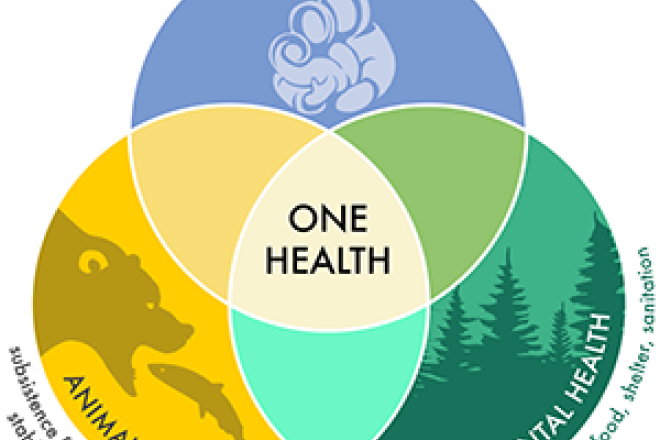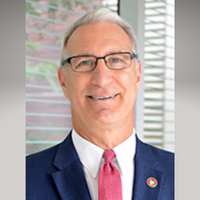One Health at Penn
At Penn, One Health is at the heart of collaborative work between veterinarians, public health experts, and environmental scientists.

By Stuti Mankodi
The idea behind One Health is simple but powerful: the health of people, animals, and the environment are deeply connected. From disease prevention to climate resilience, this interdisciplinary framework is reshaping how scientists, policymakers, and communities think about health.
At Penn, One Health is at the heart of collaborative work between veterinarians, public health experts, and environmental scientists. To understand how this concept is being translated into action, we spoke with Andrew Hoffman, Gilbert S. Kahn Dean of the School of Veterinary Medicine; Jennifer Punt, Associate Dean for One Health and Professor of Immunology; and Brianna Parsons, One Health Program Manager and researcher with the Center for Public Health.
Although they come from different corners of the One Health landscape — veterinary medicine, immunology, and sustainable agriculture — all three experts underscored how inseparable the health of people, animals, and the environment truly is. Hoffman described One Health as the recognition that the well-being of humans and animals depends on the quality of our air, water, and land, each shaped by human activity. One Health is “both a recognition and an approach,” explained Punt, emphasizing that it compels collaboration across fields and communities. She illustrated this with a familiar example, explaining how a child’s asthma sits within a broader context of air quality, pollen, and even exposure to pets, showing how local environments directly affect individual health. In Parsons’ perspective, healthy ecosystems sustain healthy people, noting that effective solutions arise when scientists, policymakers, and communities work together to define what health means in practice.
Q: Can you share a real-world example of how these systems depend on one another?
Hoffman describes climate change as the ultimate “threat multiplier,” a force that reshapes disease patterns, degrades habitats, and strains food systems, with ripple effects across economies and communities. He points out that these global shifts become visible in everyday examples.
Punt points to a 2006 E. coli outbreak traced to packaged spinach — a case that brought together epidemiologists, veterinarians, biologists, hydrologists, and farmers to trace contamination routes. The event, she notes, illustrates how food safety, agriculture, and ecology are interdependent and why collaboration across disciplines and communities is essential.
Along similar lines, Parsons highlights the role of soil health in sustaining both ecosystems and human nutrition. Practices such as crop diversity, maintaining root systems, and integrating livestock help store carbon and enrich the foods we eat, showing how sustainable farming can strengthen the link between environmental and public health.
Q: How is Penn Vet and the broader Penn community putting One Health into practice?
Penn Vet bridges veterinary medicine, human health, and environmental science through dual-degree pathways, cross-campus policy work, and new initiatives, Hoffman says. These include the Institute for Infectious and Zoonotic Disease, the Center for Stewardship Agriculture and Food Security, the Wildlife Futures Program, and Penn Climate Insights, a platform that shares climate knowledge across disciplines.
Education is central, Punt maintains. A One Campus, One Health certificate is in development to bring together undergraduates, graduates, and professional students. The aim is not only technical expertise, but also collaboration skills, systems thinking, and respect for community knowledge.
Parsons notes that the One Health in Action (OHiA) faculty group, supported by EII and a Draw Down the Lightning grant, hosts monthly research-in-progress seminars and campus events. OHiA is developing a foundations course and curating cross-school electives so students from any program can access One Health training.
Q. What are the most urgent health risks emerging from climate and environmental change?
For Hoffman, extreme weather and wildfires are among the most damaging consequences of a warming planet, destroying infrastructure, worsening air quality, and straining health systems. Rising temperatures also expand the range of mosquitoes and ticks, introducing illnesses such as dengue and malaria into new regions.
Punt agrees that vector-borne diseases are an obvious risk, and adds that not all threats are as visible. She points to quieter disruptions, such as mismatches in pollination timing and growing pressures on food security as seasons shift.
Parsons highlights heat stress that is affecting both people and livestock as another critical concern. She also notes that land-use changes, from farmland conversion to deforestation, can alter ecosystems and soil function, triggering long-term consequences for food systems, biodiversity, and human health.
Q. How did the COVID-19 pandemic influence One Health research and education?
The pandemic accelerated One Health work at Penn Vet, Hoffman notes. Penn Vet launched the Institute for Infectious and Zoonotic Disease, expanded wildlife disease surveillance, and invested in vaccinology and pandemic preparedness expertise. It also underscored the need to counter misinformation that can spill into animal health.
COVID-19 exposed gaps in how global institutions operationalized One Health early on, shares Punt. At Penn, urgency and credibility grew around cross-field collaboration and education.
Q. How can a One Health lens improve health outcomes here in Philadelphia?
Philadelphia faces environmental health disparities linked to pollution and uneven access to green space, Hoffman notes. Initiatives like Accessing Urban Nature map urban wildlife and green areas to understand benefits for mental and physical health. Education and K–12 outreach are key to empowering communities.
Integrated city services matter, says Parsons. Planning, zoning, air-quality monitoring, energy transition, tree-planting, and disease surveillance are more effective when they are coordinated and grounded in community trust.
Closing Perspective
Taken together, the three experts paint One Health as both an inclusive vision and a practical roadmap for action. Parsons emphasizes that One Health begins with people. Anyone can participate by making small, community rooted changes that grow through collaboration. Hoffman reminds us that meaningful solutions must always account for animals and ecosystems, as they are inseparable from decisions about health, infrastructure, and policy. Punt highlights the mindset that makes this possible: stepping back, recognizing connections, and asking better questions.
These perspectives converge in Penn’s expanding One Health efforts, from new cross school educational pathways and interdisciplinary research groups to community partnerships and city focused initiatives. Together, they reflect a shared belief that healthier futures emerge when people, animals, and the environment are understood not in isolation, but as part of one connected system.
Dr. Andrew Hoffman is the Gilbert S. Kahn Dean of the University of Pennsylvania School of Veterinary Medicine. A large-animal veterinarian by training, his career spans private practice, equine sports medicine, respiratory diagnostics, and more than two decades of NIH-funded research in lung disease, regenerative therapies, and translational medicine. Before joining Penn, he spent 24 years at Tufts University, where he directed multiple laboratories in equine medicine, stem-cell biology, and respiratory diagnostics. At Penn Vet, he has led major One Health and climate-related initiatives, including the Institute for Infectious and Zoonotic Disease, the Wildlife Futures Program, and the Center for Stewardship Agriculture and Food Security. His work bridges veterinary medicine, human health, and environmental sustainability.

Dr. Jennifer Punt is Associate Dean for One Health and Professor of Immunology at Penn Vet. She is an alumna of both Penn Vet (VMD) and the University of Pennsylvania (PhD in Immunology), and previously served nearly two decades on the faculty of Haverford College, along with a leadership role in student research at Columbia University’s College of Physicians and Surgeons. Her teaching and research focus on immunology, systems thinking, and interdisciplinary approaches to health, and she has been instrumental in expanding One Health educational opportunities at Penn, including new dual-degree programs, certificate pathways, and cross-school collaborations. Dr. Punt is widely recognized for her commitment to integrative teaching and for advancing One Health as both a conceptual and practical framework.

Dr. Brianna Parsons is a veterinarian, educator, and sustainable agriculture specialist whose work bridges food systems, community health, and environmental stewardship. She serves as One Health Program Manager at Penn Vet and teaches sustainable agriculture at the New Bolton Center. Her global health work includes nearly a decade in The Gambia and several years in Botswana, where she has led community-driven agricultural research, social-entrepreneurship programs, and nutrition-focused development initiatives. A graduate of Penn Vet and the Education Entrepreneurship master’s program at Penn GSE, Dr. Parsons brings an applied, community-centered perspective to One Health, emphasizing the connections among food security, environmental resilience, and human well-being.
